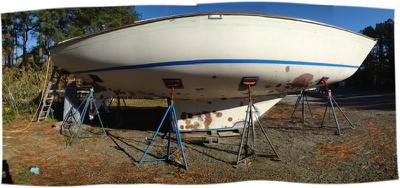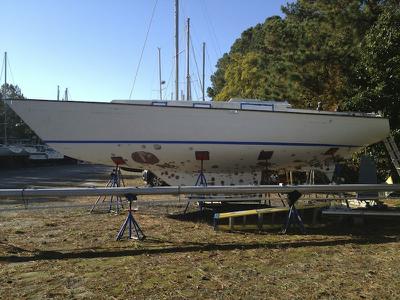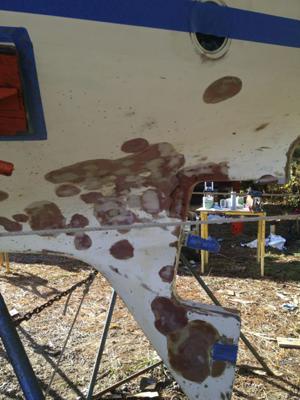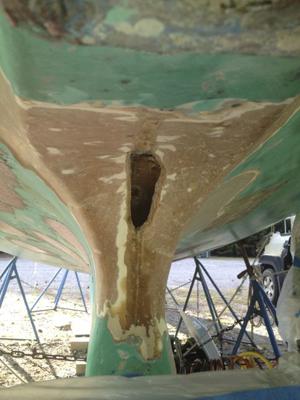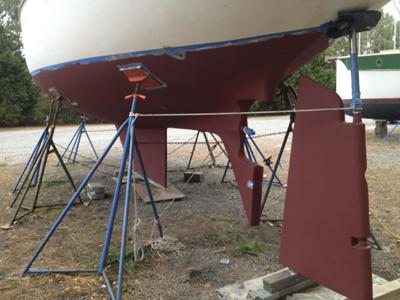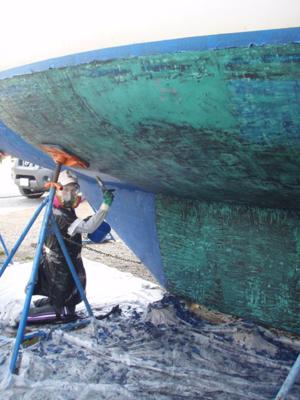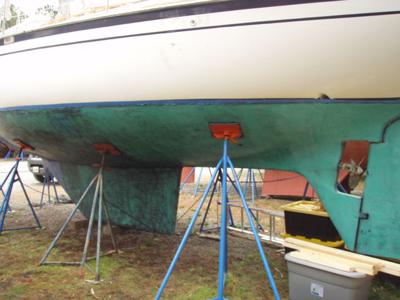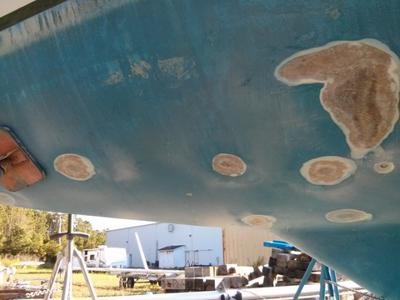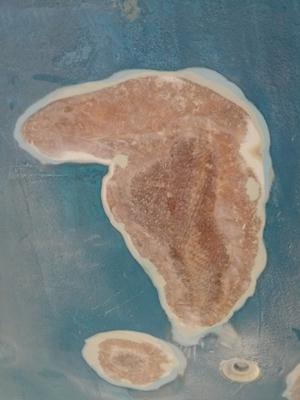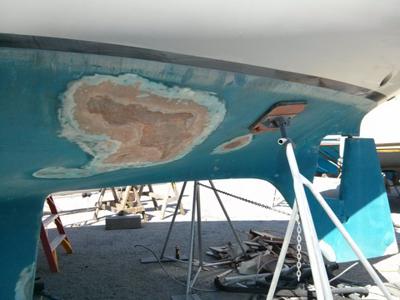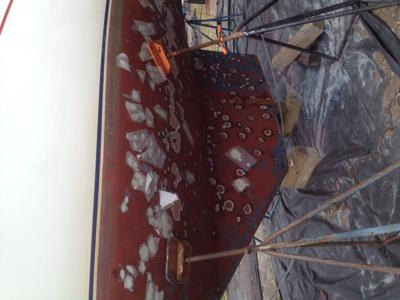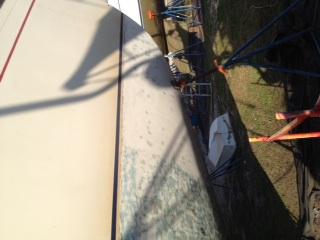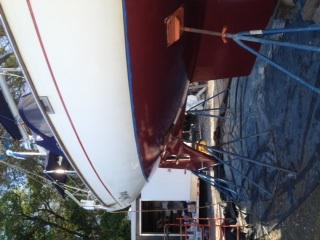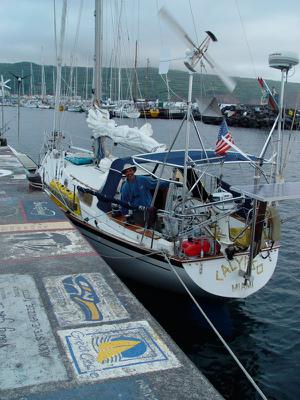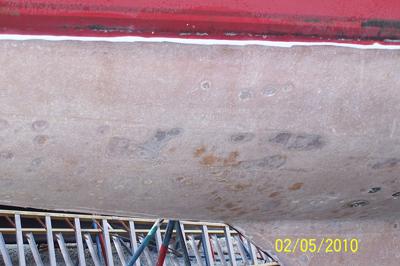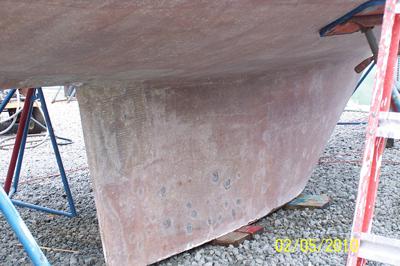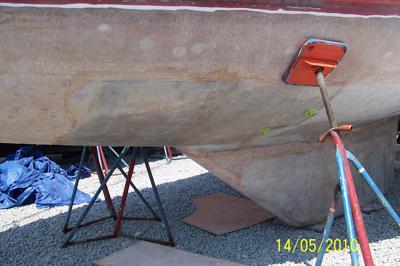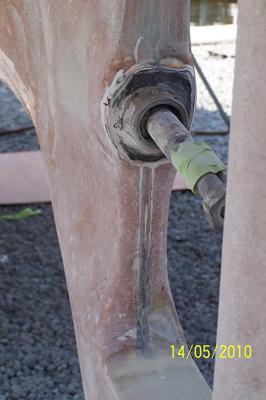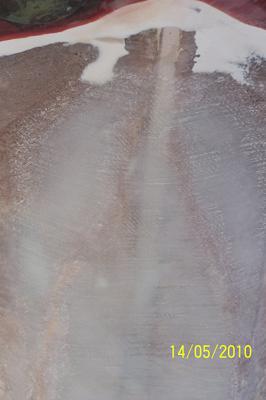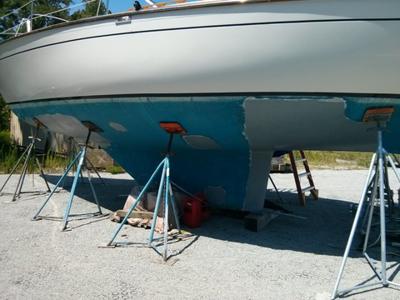In regards to the history of the boat:
It is hull #161, made in 1979. Based on the Abstract of Title I acquired when I bought the boat, it was owned by a corporation, which seemed to be a charter/rental business, for 7 years, until 1986. It was then owned privately, for 6 years, until 1992, then again privately, for 18 years, until 2010 when my wife and I bought it.
The previous private owners were Mr and Mrs Engel (I didn't know them) and Oscar Kramer (who many of you knew on this board). This is the "Calypso" that he owned.
The boat seems to have been kept in Florida waters for her entire life. I know for a fact that Oscar kept it in the water year long, but for periodic haul out for bottom painting, and would imagine it was the case for previous owners since it was in Florida.
Oscar had the boat sandblasted and barrier coated when he discovered ~ half a dozen blisters. I can confirm that since the gelcoat had sign of sandblasting and fairing over, and I found indeed half a dozen previously filled blisters. I do not know whether the barrier coating was done professionally or by Oscar, but nevertheless, it looked ok prior to us sanding it away. According to the log, it was done with a layer West System epoxy, then West System mixed with 422, and then another epoxy barrier coat on top.
--
In regards to the seriousness of the blisters/structural integrity, and whether they were blisters or voids/delaminations:
Our boat is next to the travel-lift, so we are very familiar with blisters by looking at all the boats coming in. The blisters on our Morgan were not round bubbles popping out with or without oozing coming out of it. The majority blisters were NOT apparent when the boat was pulled right out of the water.
Yes, we could see half a dozen on the keel (over the holding tank area), but we couldn't identify by sight any more than that. The surveyor pointed out the keel ones to me, and told me it wasn't a big deal, since he didn't see any more. He also did the usual tapping check around the bottom hull. The hull was deemed in good shape by the surveyor.
We first stripped the anti fouling paint with a special chemical (Star10) which allowed us NOT to smooth the bottom as one would when sanding the anti fouling paint off. We didn't chemically stripped because we planned to look for blisters, we did it because it was easier then sanding. Our plan then was to keep the old barrier coating, apply a couple coats of inter protect and move on. We decided however to open the apparent blisters on the keel.
After we grinded out the half of dozen keel blisters, and found that those were not superficial but very deep (between the 2nd mat layer and 3rd rowing layer - We actually went through to the holding with two of them), we got worried. We started to check for bumps on the old barrier coating by touch, not by sight. My wife was particularly good at this, and over time, on the 200 or so blisters found with this process, she was wrong (i.e. no void, no oozing smelly liquid) less than a dozen times.
When we then decided to sand the old barrier coating away, many more blisters became apparent. When passing the disc sander on an area, it often left a "fried egg" shape, i.e. a round fiberglass/mat looking center with white gelcoat around. This was the indication of a deep blister, where the very slight bump had the disc sander sanding more over it than around. Nearly 100% of times it was indeed a void with oozing liquid.
By the end of all this process, and while we didn't count anymore then (We were enough down on moral by then, on top of painting problems on the hull and deck), I can say for certainty there were more than 300 of them.
--
When and how did all that moisture seeped into the fiberglass?
It may have been prior to when Oscar had the boat sandblasted and barrier coated. It may have been through this barrier coating as well. I obviously cannot say.
However, it may also have been from the inside of the boat. If you look at the pictures, the biggest blisters and the greatest concentration are on the keel/holding tank area, and on the area underneath the engine, then aft of the engine (i.e. the start of the skeg), and the skeg itself. If you check inside the boat, all those areas are not protected by epoxy paint or gelcoat. It is just raw fiberglass. Yet, water tend to collect in those areas and remain there. Our holding tank was also full of water (and apparently was never ever used). Could moisture come from inside the boat instead of outside? Could that explain how deep were the blisters?
Finally, when grinding all those blisters, we found that the layering of the fiberglass contains hundreds of tiny (5mm and less) voids. Could those voids collect moisture and start becoming blisters? Is that normal in a boat fiberglass lay up? I do not know.
--
Were the blisters affecting the structural integrity of our boat?
I do not know for sure, but given how many there were on the areas mentioned above, I would argue that not much "good" area remained there.
Was the area of a given blister actually weakened?
In most cases, the liquid had eaten away the mat but the rowing was intact. So, you had 1 layer of mat, 1 of rowing, oozy liquid and dead mat, and another layer of rowing. Maybe it was strong enough... but then, why worry about delamination?
Maybe we over-reacted in grinded out all those blisters, but we feel good in thinking that all those delimitation areas are now replaced by strong layers of 1708 properly epoxied.
I do not mean to say that Morgan 382 have problematic bottoms. I believe all fiberglass boats will have blisters. I am not worried about our bottom (at least not anymore). I just want to highlight the fact that blisters may be difficult to find, especially in areas where moisture could seep in from the outside and the inside.
Cheers
Philippe


